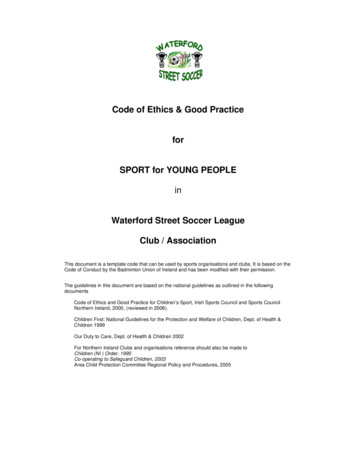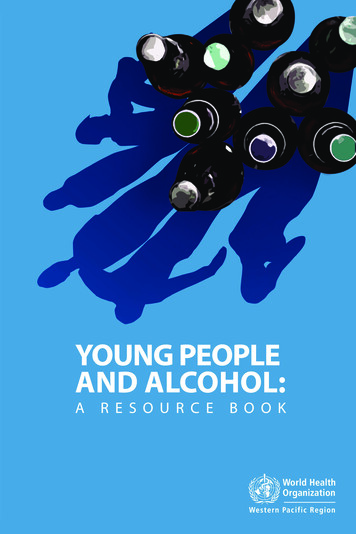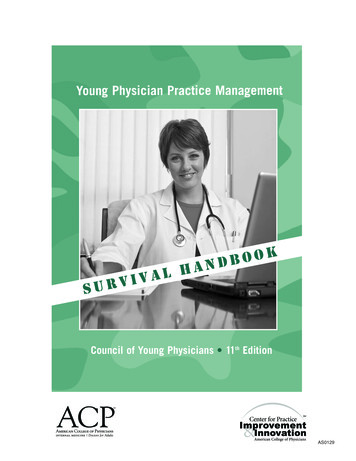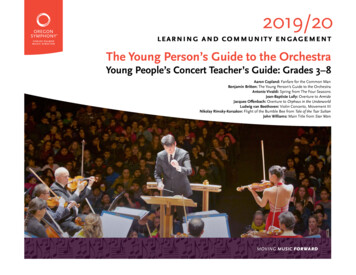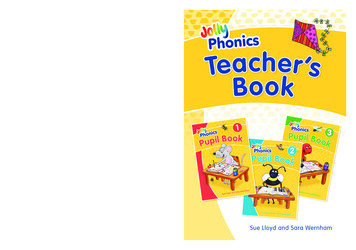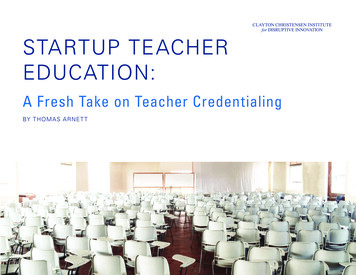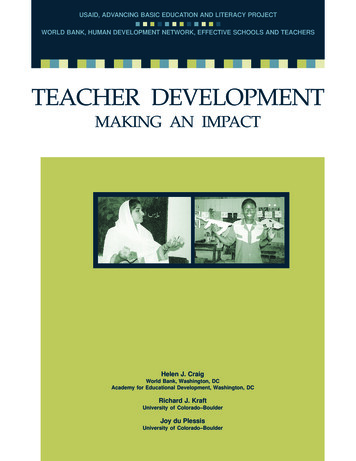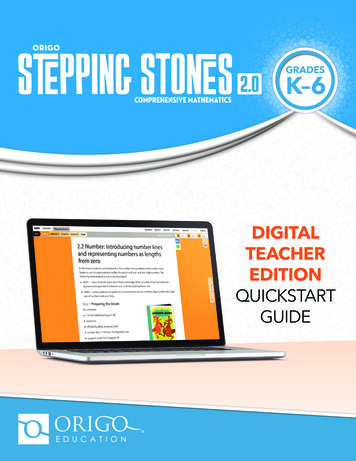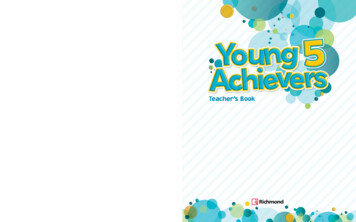
Transcription
58 St AldatesOxford OX1 1STUnited Kingdom 2016 Ediciones Santillana, S. A.Leandro N. Alem 720C1001AAP Buenos Aires, ArgentinaYoung Achievers 5 Teacher’s Book / Kate Browne .[et al.]. - 1a ed . - Ciudad Autónoma de Buenos Aires :Santillana, 2016.160 p. CD-DVD ; 28 x 22 cm.ISBN 978-950-46-5055-31. Inglés. 2. Enseñanza de Lenguas Extranjeras. I.Browne, KateCDD 420First published by Santillana Educación, S.L.ISBN: 978-950-46-5055-3Writers: Kate Browne, Sofia Diez Pereda, Brendan Dunne, Claire Fitzgerald, Pedro Antonio GarcíaCañas, Robin NewtonRecordings: EFS Television Production Ltd., Javier LupiañezPublisher: Mabel ManzanoManaging Editor: Catherine RichardsEditorial Team: Eve Hampton, Cristina Navarrete Pedraza, Elsa Rivera Albacete, Paloma RodríguezEsteban, Jason Small, Paula Fulia, Marcela SilverioDigital Managing Editor: Virginia Santidrián RuizCover Design: Manuel Estrada, Ana Lucía GaribottiDesign: Colart Design S.C.Layout: Marina Gómez Mut, María Florencia ViscontiThis Teacher’s Book includes Audio CDs.Queda hecho el depósito legal que marca la ley 11.723.Impreso en Argentina. Printed in Argentina.First Edition Published 2016The publishers would like to thank all those who have contributed to the development of this course.Websites given in this publication are all in the public domain and quoted for information purposesonly. Richmond has no control over the content of these sites and urges care when using them.All rights reserved. No part of this book may be reproduced, stored in a retrieval system ortransmitted in any form or by any means, electronic, mechanical, photocopying, recording, orotherwise, without prior permission in writing from the Publisher.The Publisher has made every effort to trace the owner of copyright material; however, the Publisher willcorrect any involuntary omission at the earliest opportunity.Este libro se terminó de imprimir en el mes de noviembre de 2016, en Artes Gráficas Rioplatense,Corrales 1393, Ciudad Autónoma de Buenos Aires, República Argentina.
Achieving goals with Young Achievers!page 2For the Studentpage 3Take a tour of the Student’s Bookpage 4For the Teacherpage 10Go Digital!page 12Key Competences for Lifelong Learningpage 13Activity Bankpage 14Student’s Book contentspage 20Unit 0 – Welcomepage 22Unit 1 – Romepage 30Unit 2 – Wild weatherpage 44Language fun! Units 0-2page 58Unit 3 – Space travel!page 60Unit 4 – We can do it!page 74Unit 5 – Super citiespage 88Language fun! Units 0-5page 102Unit 6 – Cool technology!page 104Unit 7 – Time detectivespage 118Unit 8 – Telling talespage 132Language fun! Units 0-8page 146Achieve more! Units 1-8page 148Activity Book Audio Transcriptpage 155Teacher’s Audio Material Track Listspage 158
Achieving goals withYoung Achievers!At this key stage of a child’s development and language learning,focus on the four skills is imperative. With the inclusion of models tofollow, children are supported 100% with emphasis on success andbuilding confidence.With Trinity GESE and Cambridge Language Assessment in mind,children’s ability to communicate purposefully is at the forefrontof this course. Communicative activities appear throughout eachunit and give children ample opportunities to use the vocabularyand grammar along with various communicative strategies: socialinteraction, problem solving, game playing and interpretation ofinformation.Grammar is treated as a key part of the course and is highlightedfrom the start. The focus is on production and fluency in order topromote communication. Children are given the opportunity torecycle and consolidate their knowledge of grammar at variouspoints during the course.Vocabulary is introduced using a variety of age-appropriate andhigh-interest themes and topics that are developed throughouteach unit. The key vocabulary is present not only in the exercises,tasks and activities which focus on lexical items, but it is alsointegrated into grammar and skills practice.It is essential that English language learning is treated as an integralpart of the curriculum. In order to give children a broader learningexperience there is focus on CLIL and cultural connections.Young Achievers combines a variety of English language teachingapproaches in order to give students a well-rounded learningexperience.2
For the StudentStudent’s BookThe Student’s Book is made up of a Welcome, eight main and three reviewunits. Each of the main units is divided into ten lessons plus a two-page unitreview. Throughout each unit, skills and language practice are fully integrated.Activity BookThe Activity Book provideschildren with lesson-by-lessonfurther practice of the Student’sBook content. The Picturedictionary at the back of thebook gives children an illustratedreference of the main vocabularyfrom each unit. Extra listeningpractice is available to downloadfrom the website along with allthe songs, chants and stories inthe Student’s Book.Picture dictionary3
Take a tour of the Student’s BookLesson 1Each unit opens with avariety of activities thatintroduce the topic andprovoke interest.Carefully controlledpractice of the languageis consolidated throughdialogues, role-plays,songs and games.Lesson 2Children are presented with a variety ofskills activities which contextualise thegrammar and vocabulary in each unit.Grammar is integrated into every lessonthrough model texts. Then children movetowards independent use of the language.Activity Book4
Lesson 3Children are presented witha variety of exercise typeswhich are carefully guidedand which practise a rangeof skills.Throughout each unit,children are presented with arange of text types which actas models to guide children infreer activities.Lesson 4A variety of listening activities givechildren the opportunity to hear thelanguage in use. Then children haveopportunities to practise the language,and to gain confidence whenspeaking and writing.Activity Book5
Lessons 5 and 6Children listen to and read a story. As they move through the levels the amount of text increases until theyhave the whole story written. The story is an ideal method to practise the language of the unit and extendit in a natural, familiar context.Each story aims to develop understandingof the language and literacy skills such ascomprehension, sequencing and characterdevelopment. The exercises become morechallenging through the levels in accordancewith children’s abilities and age.6Activity Book
Lesson 7Songs and chants feature in everyunit. Fun lyrics and catchy tunesmotivate children to participateand become more confident.Children are encouraged to takecontrol of their learning using variousmethods of recording language. Thisalso helps children with their ownplanning and writing.Lesson 8 - PhonicsChildren develop their pronunciationthrough Phonics by focusing on specificsounds and letters. In the early levels thefocus is on initial sounds, but as theirskills develop children move on to workwith silent letters, minimal pairs andconsonant clusters.Activity Book7
Lesson 9 - CLILEach unit includes a focus on CLIL andencourages children to see how theirknowledge of different subject areas cancross-over into English and vice versa.The Achieve more! sectionincludes more activitiesrelated to the CLIL topic.Lesson 10 - CultureA range of activities throughoutthe book give children a glimpseof various cultural aspects of lifein English-speaking countries.Hands-on project-typeactivities appear throughoutthe book which encouragechildren to work together inpairs or small groups.Activity Book8
Unit ReviewReading activitiesprovide furtherrevision but also amodel for childrento use as a guideto their ownwriting.The unit reviewconsolidates andrevises grammarand vocabularyfrom the unit. Eachexercise focuses ona different skill.The reviewwriting taskprovideschildren with theopportunity tobring togetherall the elementsof the unit andpersonalise them.Speaking tasksencourage children touse the unit language ina communicative way.Activity BookLanguage Fun!The Language fun! pages are away to review what children havelearnt over the course of threeunits through puzzles and games.These activities encourage childrento work alone, in pairs and smallgroups.Activity Book9
For the TeacherTeacher’s BookA guide with unit overviews for quick lesson plans, step-by-step guidance to Go Digital at your own pace, completeteaching notes plus extra suggestions for exploiting the course, transcripts and answer keys, assessment guidance,cross references to support material, Key competences and Activity bank to make the most of all the course materials.Assessmentguidance inevery lesson.Languageand Skillsobjectivesare clearlylisted.The supportmaterial isreferencedin every unitand lesson.The KeyCompetencesare listed foreach unit.Each lessonincludes whatto look out forand suggestionsfor dealing withdiversity in theclassroom.Clear, concise lessoninstructions make lessonplanning easy. Extrasuggestions to enhancethe Student’s Bookactivities are included.10The Activity Bookanswers are available atthe end of each lesson.Activity book transcriptsare available at the end ofthe Teacher’s Book.
Teacher’s Resource MaterialThe Teacher’s Resource Material provides a wealth of photocopiable resources which supplements the language andskills covered in the Student’s Book and is available on the website. It includes Grammar, Vocabulary, Reading, Writing,Speaking and Listening worksheets for every unit, three Festival worksheets and Tests (Diagnostic, Unit, End of termand End of year). Both the Language worksheets and Tests are presented at two levels to suit different abilities within theclass. There are also suggestions for the ideal moment to use each worksheet.UnitUnit2TestVocabularySupport11 Find and circle. Then, complete the words.lig haxcin gjkkc b w ttny pfzgth u n d erstoo ojxzslnjg crin afioljb niu w bfsan u m cadxy n b o cyi m lrrn vlo w oftrk g w g by4. ww ditn3. rqn hg2. fvt23y7. lzsrcizib y8. sssrtnjdzdfycoldrainysnowy2. tomorrow morningcloudyhumidfoggywindy3. tomorrow afternoonicywindyrainysunny4. tomorrow 5. the rest of the week2 Look and read. Write sentences with may, might or could. (3 points)o6. tk q x q g d evfreezingm5. tav q u o vcName:Listen to the weather forecast and circle two words. (8 points)1. tonight1. fr mk2ConsolidationName:grainhave a testgo horse ridinggh k1232 Look and complete.cloudcloudyshiningfog foggy freezing rainingsnow snowing snowy windVerbsNounsrainyAdjectives 3 Read and write the correct word.lightning1. It’s2. Therainingthundertornadoeswind.3. It.3 Read and match. (3 points)1. They mustn’ta lot outside, take your umbrella.is very strong today. You can hear it whistling around the house.3. The storm was very scary, there was28snow1. She2. Weand4.are the most violent storms on Earth.5.covers the ground for half the year in Finland.Photocopiable Santillana Educación, S.L.116a. to go to bed early tonight. We can sleep late tomorrow!2. We don’t haveb. to do a Maths test tomorrow. I missed it last week.3. I havec. forget to do their homework. If they forget, the teacher will be cross.4. You mustd. tidy up the mess you made in the kitchen.Photocopiable Santillana Educación, S.L.Teacher’s Audio MaterialThe pack includes 2 audio CDs:t Audio CDs 1 and 2t The Activity Book Audio tracks are available on thewebsite and so are the Teacher’s Resource MaterialAudio tracks.Flashcards and Word Cards82 photo flashcards each with an accompanying wordcard are available on the website for you to print out.You can also make them yourself with your students’help out of magazine cut-outs. They are ideal forpresenting, reinforcing and reviewing vocabulary. Thereare also games suggestions in the Activity Bank on page16 of the Teacher’s Book. The flashcards are reproducedin the Picture Dictionary in the Activity Book.11
Go Digital!Tailor your digital teaching! Richmond teachers decide what digital materials they ortheir pupils will use in the classroom or at home. Digital resources are the perfect aid toenhance your teaching, motivate children and make the most of all the course materials.Digital BookThe Digital Book is an interactiveversion of the Student’s Book, whichincludes the audio material for usewith IWB or projector.The Young Achievers GameThe solution for yourchildren to learn andhave fun. Availableon the website, theTreasure Islandgame is ideal forfast finishers, aswrap-up activitiesor homework. Thegame encourageschildren to getthe best results tounlock the next unit.12It also includes the Webquest challenge.
Key Competences for Lifelong LearningKey competences combine the necessary knowledge,skills and attitudes to develop and achieve success aswell as to be active in all areas of social and civic life.Each of the competences is equally important and forthat reason there are many shared goals which supportand underpin one another. The basic skills of language,literacy, numeracy and information and communicationtechnologies provide the foundation blocks for criticalthinking, creativity, initiative-taking, problem-solving,decision-making and management of feelings.Young Achievers works on the following Key Competences as set out by the European Commission:LCMSTLLinguisticcompetenceTThis competence develops the use of language as a tool for communication. It involves understanding oralmmessages, communicating verbally, reading and writing. The games and personalised activities in the seriesmmotivate children to speak right from the outset. The emphasis on understanding oral messages is developedththrough the stories, dialogues and songs where children learn to listen to extract relevant information. Theaability to read and understand texts is systematically introduced and developed throughout the series.MMathematicalcompetence and basic competences in Science and TechnologyThese competences develop the ability to use numbers and mathematical reasoning to solve a range ofTpproblems and to use science to explain the natural world. The course provides plenty of opportunities forcchildren to apply their mathematical thinking in everyday contexts, for example, telling the time, usingccharts, completing surveys or sequencing events. Children are made aware of the world around them andthe effect human activity has on it.thDCDDigitalcompetenceThis competence involves the confident use of computers and other technology for learning, communicationTaand recreation. Through the integration of digital and multimedia resources, children develop familiarity andccompetence in this area. Children are encouraged to use the interactive material and, in higher levels, toresearch information on the internet.reSCCSocial and Civic competencesSThese competences equip children with the necessary skills to participate fully in social and civic life.TCollaboration and tolerance is developed throughout the course by the inclusion of pair and group work.CChildren learn about healthy lifestyles, empathise with characters in the stories and learn social rules throughCgames and role-plays.gCAECultural awareness and expressionThis competence is developed through a wide range of fun songs, chants, drama, stories and craft activities.TThe pop-outs provide the opportunity to create and assemble games which are then used for language practice.TThere is also a strong emphasis on appreciation and enjoyment of culture by the inclusion of popular storiesTand works of art. The culture focus present in each unit shows aspects of life in English-speaking countries.LLLLearningto learnThis competence means children develop and become aware of effective ways to organise and manageTttheir own learning. The incorporation of the unit reviews encourages children to be responsible, self-awarellearners who can reflect on their own progress. Throughout the course children are offered opportunities tobuild on prior learning, to apply their knowledge and to make use of guidance.bIESense of initiative and entrepreneurshipSThis competence refers to the ability to turn ideas into actions. The skills to be able to work both proactivelyTaas a member of a team and individually are developed by activities where children create a product.Throughout the course they are continually encouraged to use their imagination and to be creative.T13
Activity BankClassroom DynamicsStart as you mean to go onThe beginning of the class is a key time for promotinga caring environment in your class. Have a miniconversation with a couple of children while the rest ofthe class are listening, ask about their family, likes anddislikes and so on. This allows everyone to learn moreabout each other and as you show a genuine interest ineach child you will establish immediate rapport with allthe children.BirthdaysThis is often the most important event in a child’s calendarand offers a great opportunity to show that we valuethem. It is a good idea to keep a birthday chart on theclassroom wall. Make sure not to forget those childrenwhose birthdays are in the holidays or on non-school days.Your voiceThis is your most powerful teaching tool. How you useyour voice is key to getting the children’s attentionand holding their interest but it also gives strongmessages about how you feel about them as a class andas individuals. Every time you talk to your class or theindividuals in it, you are providing a model of how youwant them to talk to each other.It costs nothing to be politeHello, goodbye, please and thank you are so easy to learnand are important markers of respect. If you insist onsing these conventions you will promote mutual respectusingmong your students.among14HumourNoticing the funny side of things and encouraging sharedlaughter (not at anyone’s expense) will help create a muchhappier classroom environment.GroupingHave a flexible approach to grouping. Although it issometimes a good idea to group more able or less ablechildren together so they can work at their level, it canbe really demotivating if they feel they are in the weakgroup. Try to mingle children as much as possible.Always be aware of dynamics within groups too. Ifchildren are not happy together, their learning processcan be impaired.Roles and responsibilitiesMost children value being given responsibility, this canbe as simple as handing out pencils. These roles showthat you trust the child to act responsibly. Althoughassigning tasks can be seen as a reward, it is important tomake sure that all the children get the chance to step upas helpers.ChoiceOffer children choices wherever possible as it will givethem a greater sense of ownership in the class and italso helps establish a culture of negotiation. For younglearners, this can be as simple as choosing the songor story, but can be built on throughout the course topromote more autonomous learning.
Classroom displayChildren really value their work when it is displayed inclass and you encourage other children to notice andpraise it. It also motivates children to produce good workand think about presentation.Class RulesYour children are more likely to abide by class rules if theyfeel some ownership of them. They will be well aware ofhow they should behave in class. Drawing up a list of classrules is a great way to bring the class together and to getthem to think about how it affects them as individualswhen others do not respect each other or the space theyare sharing. It is also a good reference point throughoutthe year and can be pointed out at any point.Stories that teachThere is an enormous wealth of children’s books andstories that deal with a wide range of moral and socialissues. They can help children learn about and come toterms with some of the difficulties of living and growingup together. If you do not have access to a library, howabout starting your own collection of edifying children’sstories? If you include these in your lessons, you will givechildren a much richer education and provide referencepoints when dealing with some of the issues that maycome up.AssessmentObservationObserving children in class and making regular noteson their development can complement more formalassessment techniques, and help build a more completepicture of each child. Keep on-going notes in a notebookwith a page (or pages) for each child. It is hard to observeall the children on a regular basis, so try focusing ontwo or three children each lesson or week. Alternatively,choose a specific area of language learning to observeeach week.PortfoliosA portfolio is a collection of each child’s work from overthe course of a term or school year. It is useful as anassessment tool as we can observe a child’s progress intheir written work throughout the year. It can also be astarting point for one-to-one interviews with children totalk about their learning and progress.Self-assessmentSelf-assessment activities can give teachers usefulinformation about how children learn best, how they feelabout their progress and what they enjoy about learningEnglish. Self-assessment can take many different forms.To look at learning strategies, how about preparing aquestionnaire about the activities that help children learnnew words?I learn new words by 1. Singing songs with the wordsYesSometimes No2. Playing games with the wordsYesSometimes No3. Writing the words in my notebookYesSometimes No4. Doing exercises in the Activity BookYesSometimes No5. Looking at a poster or picturesYesSometimes No6. Doing actions and mimesYesSometimes NoChildren can respond individually and then discuss as aclass and so become more aware of different learningstrategies. Ask them to recall what they have learnt atthe end of each lesson or unit. Asking them to rate howhard they have worked can also make them notice howmuch effort they are putting into their learning. Anotherapproach to self-assessment is to ask children to set somesimple goals for the next week’s/unit’s/term’s work. Goalscan include things like: I want to speak English with myfriends in class, I want to write new words in my notebook.Ask children to write their goals down and at the endof the week or term, speak to each child individually todiscuss whether they have achieved their goals or notand why/why not.Making the most of the registerRather than just reading out the names to elicit a Yes orPresent from children, try asking them all to answer aquestion when their name is said. For example, Today,I want everyone to say a TV programme you like or Today,tell me about your favourite sport. You can get to knowmore about your pupils and their lives, but also find outwho can give more extended answers.Attention to DiversityThinking timeTo include everyone when answering questions, tellchildren to stay quiet and put up their hands when theyhave an answer so everyone has time to think. Alternatively,have a pot of name cards and take names at random toanswer questions so that all the children have a turn.15
PraisePraise all the children, not just for the standard of theirwork, but for making an effort, showing improvementsor helping others. Be enthusiastic and try to give helpfulfeedback too. For example, That’s great! Your writing isvery clear and neat, it helps me to read it.Working in pairs and groupsOrganise groups in a variety of ways depending on theactivity. Mixed-ability groups work well, for example,while playing a game and remember weaker childrencan often learn more from a fellow classmate. For otheractivities, it can be more productive to group strongerchildren together while you give more attention to aweaker group. Try to avoid having an identifiable groupwhere weaker children are always together.Accessible learningMake instructions and tasks accessible to all the children.Some children benefit if you accompany instructionswith gestures or pictures or if you show them a finishedexample. Demonstrate tasks as much as possible andprovide visual references, for example, display a posteror put up flashcards.Fast finishersTo avoid boredom or frustration, have activities ready forfast learners, for example, simple wordsearches, a pictureto label, a picture book to read. Alternatively, ask fastfinishers to help other children with their work.Flashcards GamesMime gameHold a flashcard over a volunteer’s head so that the classcan see it, but the child cannot. Children mime the wordfor the volunteer to guess. Alternatively, show the card justto the volunteer who then mimes it for the rest of the class.Pelmanism on the boardPut picture cards face down on one side of the board andword cards on the other. Divide the class into two teams.A member from Team A turns over a picture card and aword card and says the words. If the cards match, theykeep them and the team gets a point. If the cards do notmatch, the child puts them back as before.Read my lips!Put the flashcards on the board and silently mouth aword. Children try to read your lips. The first child toguess the word mouths the next word.What’s the word?Hold a flashcard so that children cannot see it. Describethe word for the class to guess. For example, It’s ananimal. It can’t fly. It’s long. It hasn’t got any legs. (A snake)Easy mathsStick the flashcards to the board and write a numberunder each one. Engage children into doing sums, cyclingplus tennis. Children add the numbers and say the wordthey add up to, swimming. This game can be played withaddition (cycling plus tennis) or subtraction (basketball takeaway football).Vocabulary GamesNoughts and crossesDraw a three-by-three grid on the board. Divide the classinto two teams and assign noughts to Team A and crossesto Team B. Ask Team A a vocabulary question, if theyanswer correctly they draw a nought in a square. ThenTeam B has a turn. The winner is the first to draw threenoughts or crosses in a row.Word tennisDivide the class into two teams. Choose a category(transport) and ask Team A to say a transport word. TeamB have five seconds to say a different word, then Team Ahave five seconds to say another word and so on. If theycannot think of a word in five seconds or if they repeat aword, then the other team win the point.16
Mr Green likesWrite ‘Mr Green likes ? ’ on the board. Invite the classto ask you questions to find out what Mr Green likes: DoesMr Green like cheese? (Yes), Does Mr Green like Maths?(No), Does Mr Green like books? (Yes). The aim is to findout what all the things Mr Green likes have in common:they are all words with double letters.12 LettersDivide the class into teams and write 12 letters on theboard (including at least three vowels). Give the teamsfive minutes to make as many words as they can with theletters. The team with most words is the winner.Change placesAsk children to sit in a circle of chairs. Say Change placesif you like Maths and encourage children to change seats.Repeat with other sentences: Change places if you’ve got acat, Change places if you’re wearing jeans, etc.BasketballDivide the class into two teams. Ask Team A a question(Say six ocean animals). If they answer correctly, theyscore a point. Invite a volunteer from the team to thefront and give him/her a ball. Ask them to try and throwthe ball into a basket or bin three or four metres away.The team scores a second point if the volunteer gets theball in the basket.Stop the bus!Divide the class into teams and give each team a piece ofpaper. Write these category headings on the board: Food,Animals, Sport, Verbs. Say a letter (G) and ask the teamsto write a word for each category on their piece of paper(Grapes, Giraffe, Golf, Go). The first team to write fourwords, calls Stop the Bus! and wins a point.Grammar GamesSentence PictionaryWrite some sentences on pieces of paper: I don’t likespiders. Divide the class into teams and invite a volunteerto the front. Give the volunteer a sentence and askthem to draw a picture of it. The teams try to guess thesentence for a point.What’s the missing word?Divide the class into teams and give each team somepieces of paper. Write a sentence on the board with amissing word: My sister like cheese. Give the teams 20seconds to decide the missing word and write it on thepaper. Tell the teams to hold up their paper slips and givepoints to teams with the correct word.Throw the ballAsk the class to stand in a circle. Throw a ball to a childand ask a question. What time do you get up? The childanswers and then throws the ball to another child andasks a question. This game can be played with Whattime do you ? Did you yesterday? or Have you got ?questions.20 QuestionsAsk a volunteer to the front and ask her/him to thinkof a famous person. Children ask the volunteer yes/noquestions to find out who it is: Are you a man? Are you awoman? Have you got long hair? Are you a singer? Childrencan ask up to 20 questions to try to guess who the famousperson is. As a variation, the volunteer can think ofsomeone in the class.17
Odd word outDivide the class into teams. Say four words: eagle, parrot,ostrich, owl. Ask each team to choose the odd word outand give a reason to win a point: Ostrich, because ostrichescan’t fly. Owl, because owls wake up at night.Can you remember?Ask children to sit in a circle. Say I played tennis yesterdayand ask the first child in the circle to repeat the sentenceand extend the sentence, for example: I played tennis andI read a comic. Then, the next child repeats the sentencesand extends further, and so on.Songs and ChantsActionsCombining language production with movement is apowerful way to fix language. It also makes the experiencemore enjoyable and gives children who are not confidentwith singing a chance to join in the activity. For songs thatdo not have obvious accompanying actions, get childrento invent them.Clap the rhythmRead out a line from the song. Then read it again butthis time clap with each syllable. Encourage children tojoin in. Then clap the rhythm without saying the lines.Repeat this for each line of the song. You can get childre
The Student’s Book is made up of a Welcome, eight main and three review units. Each of the main units is divided into ten lessons plus a two-page unit review. Throughout each unit, skills and language practice are fully integrated. The Activity Book provides children with lesson-by-lesson further practic
